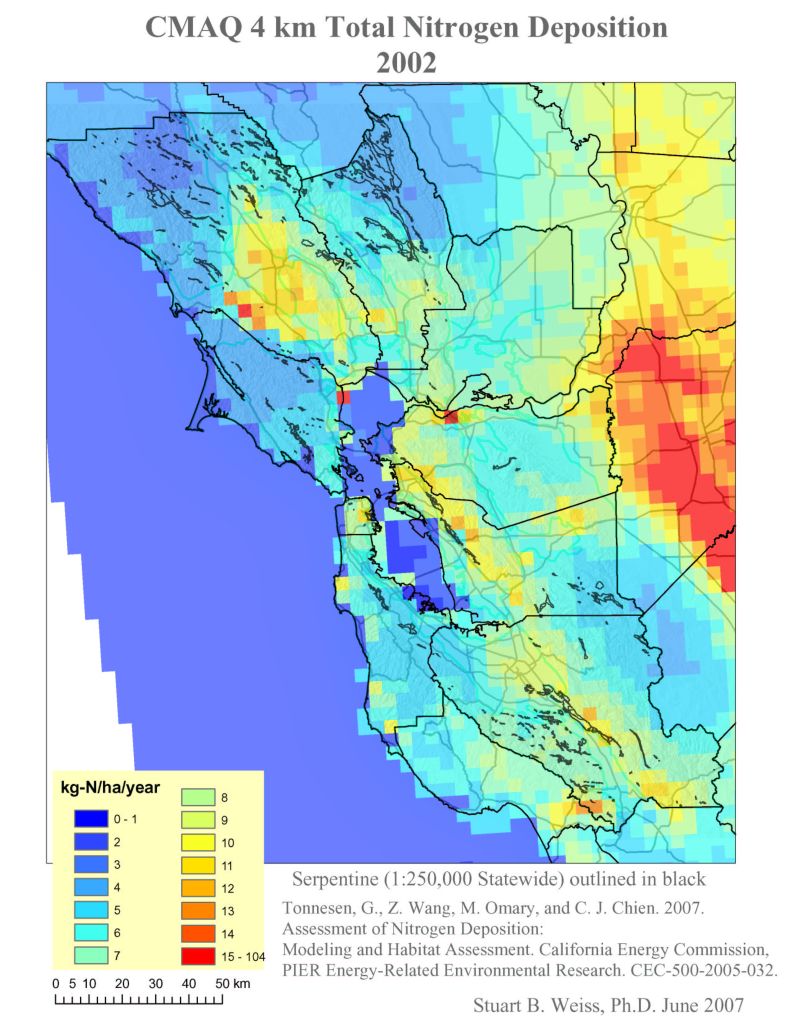
The Goal: Understand and mitigate impacts of atmospheric
nitrogen deposition on ecosystem function and biodiversity
conservation.
The Problem: Atmospheric nitrogen (N) deposition causes
widespread “chemical climate change” that profoundly
alters ecosystems and threatens native biodiversity by nitrogen overdose.
The Conservation Success Story: The Creekside Center for Earth Observation is an innovative leader in addressing N deposition impacts on important conservation areas.
For example, the Bay checkerspot butterfly occupies flower-filled, nutrient-poor serpentine grasslands downwind of San Jose, CA. Silicon Valley smog delivers 10-20 kg N/ha/yr to this habitat, which allows exotic annual grasses to displace native species. Grass invasions are being held in check by moderate cattle grazing. Innovative mitigation for power plants, freeway expansion, and urban development
promises to deliver permanent protection and management of virtually the entire remaining ecosystem. The mitigation involves land purchases and easements, management endowments, ecological restoration, and habitat conservation planning.

- Monitoring N deposition: provide technical assistance with design and implementation of monitoring networks, and geographic information system (GIS) based analysis;
- Impacts on biodiversity: assess ecosystem impacts of N enrichment (weed invasions, shifts in species composition, etc.) and associated risk for loss of biodiversity;
- Mitigation planning: work with agencies, industry, NGOs, and others to develop mitigation plans, including land purchases and long-term adaptive management;
- Mitigation implementation: initiate site-specific, science-based restoration (burning, mowing, planting, etc.) and ongoing monitoring
- Education and outreach: communicate with diverse audiences (public, landholders, resource managers, decision makers, elected officials, etc.) through various media (press, field tours, web sites, briefing papers, presentations, brochures, etc.)

- Stuart B. Weiss, PhD and Chief Scientist, Creekside
Center for Earth Observation, stu at creeksidescience.com
Download nitrogen deposition conservation vision pdf
Key Literature
Fenn, M.E., J.S. Baron, et al. 2003. Ecological effects of
nitrogen deposition in the western United States. Bioscience 53:
404–420. pdf
Weiss, S.B. 2006. Impacts of nitrogen deposition on California
ecosystems and biodiversity, California Energy Commission
Report. pdf
Weiss, S.B. 1999. Cars, cows, and checkerspot butterflies:
nitrogen deposition and grassland management for a
threatened species. Conservation Biology 13:1476-1486. pdf
Weiss, S.B. 2002. Final report on NFWF grant for habitat
restoration at Edgewood Natural Preserve, San Mateo County,
CA. Creekside Center for Earth Observation Report, Menlo
Park, CA. pdf part1 & pdf part2
